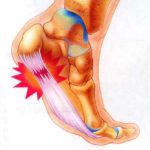
What is Plantar Fasciitis?
Plantar fasciitis (PF) is the term used to describe foot pain that occurs in the heel or arch of the foot. Typically brought on by overuse, like running or walking long distances, PF can be difficult to treat because the inflammation is in the fascia or ligamentous tissue on the bottom of the foot.
Typical approaches to treatment include cortisone shots to reduce inflammation, orthotics to support the foot, and protective boots worn at night to prevent the foot from contracting, but no one treatment works for everyone.
In my practice I treat a ton of foot and ankle injuries. That’s because my background as a runner has given me first-hand experience with almost all of them. I have had, and successfully treated, plantar fasciitis in both of my feet over the years, so I know how to treat it.
Ask the Expert: Dr. Lawrence Oloff
So what can you do if arch and heel pain affect you? I talked to Lawrence Oloff of SOAR Medical Group and Team Podiatrist for the San Francisco Giants to get his perspective on the best way to resolve this condition.
What is plantar fasciitis?
The ‘plantar fascia’ is a ligament in the arch that attaches to the heel and runs the length of the foot. Fasciitis represents a condition where the plantar fascia gets inflamed and irritated, resulting in heel pain in the bottom of the foot.
Who gets PF?
It is more common in active people but can be witnessed in anyone. It is more common with foot structural issues such as high arch feet and flat feet. Walkers, runners, and hikers are particularly prone to it. As running is a major part of conditioning for many sports, it is witnessed as one of the most common sports overuse injuries.
How do I know if I have PF?
Fasciitis symptoms are expressed as heel pain on the bottom of the foot, that is exacerbated by standing and walking. People express their worst pain when first getting out of bed, or out of a chair, or when exiting a car.

How do you treat PF in you office?
The first line of treatment involves simultaneous approaches such as: temporary use of anti-inflammatory medicines (if medically allowed) such as Advil or Aleve, over the counter orthotics or padded heel cups, icing, stretching (arches, calves, and hamstrings), night splints (check out night splints.com), and elimination of irritating weight bearing activities.
How long does PF last?
Be patient because it can take months to totally improve.
Any quick fixes?
Checkout your shoes and make sure they are supportive enough, or maybe its just time to replace that worn out running shoe.
What if it just doesn’t get better?
Options for stronger treatment include prescription-strength anti-inflammatory medications, limited use of cortisone injections, or custom orthotics. Stress fractures of the heel bone are not that uncommon. These typically present with pain on the sides of the heel versus the bottom. An x-ray, and maybe a MRI is needed for a more precise diagnosis.
Acupuncture for Plantar Fasciitis
While needles in the foot may seem counterintuitive for this kind of pain, acupuncture can be really effective and releasing foot tension. That’s because acupuncture works to increase circulation to certain parts of the body and can release acute muscle spasm.
Master Tung’s Heel Point
One acupuncture point in particular has been especially in treating plantar fasciitis. Master Tung (one of the most famous acupuncturists in modern times) used a point halfway up the inside of the upper thigh to treat heel pain. This point releases tension in the Achilles tendon, thereby taking tension off the bottom of the foot.
A Comprehensive Approach
Whether you start with massage, physical therapy, or new pair of shoes, many approaches to treating PF will work. The trick is to find the therapy or therapies that work for you. A Podiatrist, Physical Therapist, or Acupuncturist can all be good places to start.

Ted Ray
Contact Me



